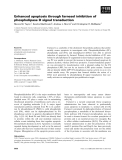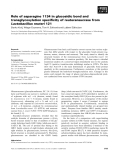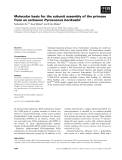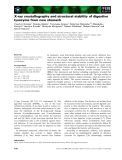
Bacteria biochemical studies
-
We have recently expressed in bacteria the enzymatically active reverse transcriptase (RT) of bovine leukemia virus (BLV) [Perach, M. & Hizi, A. (1999) Virology 259, 176–189]. In the present study, we have studied in vitro two features of the DNA polymerase activity of BLV RT, the processivity of DNA synthesis and the fidelity of DNA synthesis. These properties were compared with those of the well-studied RTs of human immunodeficiency virus type 1 (HIV-1) and murine leukaemia virus (MLV).
 9p
9p  research12
research12
 01-06-2013
01-06-2013
 43
43
 4
4
 Download
Download
-
Staphylokinase (SAK) is a 15.5-kDa protein fromStaphy-lococcus aureusthat activates plasminogenby forminga1 : 1 complex with plasmin. Recombinant SAK has been shown in clinical trials to induce ®brin-speci®c clot lysis in patients withacutemyocardial infarction.However, SAKelicits high titers of neutralizing antibodies. Biochemical and protein engineering studies have demonstrated the feasibility of generatingSAKvariantswith reducedantigenicity yet intact thrombolytic potency.
 7p
7p  research12
research12
 23-04-2013
23-04-2013
 43
43
 3
3
 Download
Download
-
It was shown previously [Riedinger, H. J., van Betteraey-Nikoleit, M & Probst, H. (2002)Eur. J. Biochem.269, 2383–2393] that initiation ofin vivo SV40 DNA replication is reversibly suppressed by hypoxia in a state where viral minichromosomes exhibit a nearly complete set of repli-cation proteins. Reoxygenation triggers fast completion and post-translational modifications.
 11p
11p  tumor12
tumor12
 20-04-2013
20-04-2013
 31
31
 2
2
 Download
Download
-
Farnesol is a catabolite of the cholesterol biosynthetic pathway that prefer-entially causes apoptosis in tumorigenic cells. Phosphatidylcholine (PC), phosphatidic acid (PA), and diacylglycerol (DAG) were able to prevent induction of apoptosis by farnesol. Primary alcohol inhibition of PC cata-bolism by phospholipase D augmented farnesol-induced apoptosis. Exogen-ous PC was unable to prevent the increase in farnesol-induced apoptosis by primary alcohols, whereas DAG was protective.
 8p
8p  fptmusic
fptmusic
 12-04-2013
12-04-2013
 35
35
 2
2
 Download
Download
-
In Gram-positive bacteria, the expression of iron-regulated genes is medi-ated by a class of divalent metal-dependent regulatory (DmdR) proteins. We cloned and characterized twodmdR genes of Streptomyces coelicolor that were located in two different nonoverlapping cosmids. Functional ana-lysis of dmdR1anddmdR2was performed by deletion of each copy. Dele-tion of dmdR1resulted in the derepression of at least eight proteins and in the repression of three others, as shown by 2D proteome analysis.
 11p
11p  awards
awards
 05-04-2013
05-04-2013
 36
36
 4
4
 Download
Download
-
A gene with significant similarity to bacterial Lon proteases was identified during the sequencing of the genome of the thermoacidophilic archaeon Thermoplasma acidophilum. Protein sequence comparison revealed thatThermoplasma Lon protease (TaLon) ismore similar to theLonBproteases restricted to Gram-positive bacteria than to the widely dis-tributed bacterial LonA.
 5p
5p  awards
awards
 05-04-2013
05-04-2013
 41
41
 2
2
 Download
Download
-
Employing transgenic plants as alternative systems to the conventional Escherichia coli, Pichia pastorisor baculovirus hosts to produce recombin-ant allergens may offer the possibility of having available edible vaccines in the near future. In this study, two EF-hand-type Ca 2+ -binding allergens from olive pollen, Ole e 3 and Ole e 8, were produced in transgenic Arabid-opsis thaliana plants.
 10p
10p  inspiron33
inspiron33
 25-03-2013
25-03-2013
 41
41
 3
3
 Download
Download
-
Glucansucrases from lactic acid bacteria convert sucrose into variousa-glu-cans that differ greatly with respect to the glucosidic bonds present (e.g. dextran, mutan, alternan and reuteran). This study aimed to identify the structural features of the reuteransucrase from Lactobacillus reuteri121 (GTFA) that determine its reaction specificity.
 8p
8p  inspiron33
inspiron33
 25-03-2013
25-03-2013
 52
52
 3
3
 Download
Download
-
Candida albicansis the most prevalent yeast pathogen in humans, and recently it has become increasingly resistant to the current antifungal agents. In this study we investigatedC. albicansdihydroorotate dehydroge-nase (DHODH, EC 1.3.99.11), which catalyzes the fourth step ofde novo pyrimidine synthesis, as a new target for controlling infection.
 9p
9p  inspiron33
inspiron33
 25-03-2013
25-03-2013
 48
48
 4
4
 Download
Download
-
Soluble inorganic pyrophosphatases (inorganic diphosphatases, EC 3.6.1.1) were isolated and characterized from three phylogenetically diverse cyano-bacteria)Synechocystis sp. PCC 6803, Anabaena sp. PCC 7120, and Pseudanabaenasp. PCC 6903 – and one anoxygenic photosynthetic bacter-ium, Rhodopseudomonas viridis(purple nonsulfur).
 12p
12p  galaxyss3
galaxyss3
 21-03-2013
21-03-2013
 45
45
 5
5
 Download
Download
-
Ammonium assimilation is tightly regulated in nitrogen-fixing bacteria; the target of regulation is primarily the activity of the key enzyme glutamine synthetase that is regulated by reversible covalent modification by AMP groups in reactions catalysed by the bifunctional adenylyltransferase (ATase). The properties and regulation of ATase fromEscherichia colihave been studied in great detail.
 12p
12p  galaxyss3
galaxyss3
 21-03-2013
21-03-2013
 44
44
 4
4
 Download
Download
-
Archaeal⁄eukaryotic primases form a heterodimer consisting of a small cat-alytic subunit (PriS) and a large subunit (PriL). The heterodimer complex synthesizes primer oligoribonucleotides that are required for chromosomal replication. Here, we describe crystallographic and biochemical studies of the N-terminal domain (NTD) of PriL (PriL NTD ; residues 1–222) that bind to PriS from a hyperthermophilic archaeon, Pyrococcus horikoshii, at 2.9 A ˚ resolution.
 12p
12p  galaxyss3
galaxyss3
 21-03-2013
21-03-2013
 41
41
 3
3
 Download
Download
-
Type III secretion systems of Gram-negative pathogenic bacteria allow the injection of effector proteins into the cytosol of host eukaryotic cells. Cros-sing of the eukaryotic plasma membrane is facilitated by a translocon, an oligomeric structure made up of two bacterial proteins inserted into the host membrane during infection.
 10p
10p  galaxyss3
galaxyss3
 19-03-2013
19-03-2013
 41
41
 4
4
 Download
Download
-
Lipopolysaccharide is a major constituent of the outer membrane of Gram-negative bacteria. It activates monocytes and macrophages to produce cytokines such as tumor necrosis factor-aand interleukins IL-1b and IL-6. These cytokines appear to be responsible for the neurotoxicity observed in peripheral nervous system inflammatory disease.
 11p
11p  galaxyss3
galaxyss3
 07-03-2013
07-03-2013
 37
37
 4
4
 Download
Download
-
Seryl-tRNA synthetase (SerRS) is a class II aminoacyl-tRNA synthetase that catalyzes serine activation and its transfer to cognate tRNA Ser . Previ-ous biochemical and structural studies have revealed that bacterial- and methanogenic-type SerRSs employ different strategies of substrate recogni-tion.
 14p
14p  media19
media19
 06-03-2013
06-03-2013
 50
50
 3
3
 Download
Download
-
Ferredoxin (flavodoxin)-NADP(H) reductases (FNRs) are ubiquitous flavoenzymes that deliver NADPH or low-potential one-electron donors (ferredoxin, flavodoxin, adrenodoxin) to redox-based metabolic reactions in plastids, mitochondria and bacteria. Plastidic FNRs are quite efficient reductases.
 17p
17p  media19
media19
 06-03-2013
06-03-2013
 31
31
 3
3
 Download
Download
-
In ruminants, some leaf-eating animals, and some insects, defensive lyso-zymes have been adapted to become digestive enzymes, in order to digest bacteria in the stomach. Digestive lysozyme has been reported to be resis-tant to protease and to have optimal activity at acidic pH. The structural basis of the adaptation providing persistence of lytic activity under severe gastric conditions remains unclear.
 9p
9p  viettel02
viettel02
 22-02-2013
22-02-2013
 40
40
 3
3
 Download
Download
-
Periplasmic binding proteins are abundant in bacteria by virtue of their essential roles as high-affinity receptors in ABC transport systems and chemotaxis. One of the best studied of these receptors is the so-called glucose⁄galactose-binding protein. Here, we report the X-ray structure of the Salmonella typhimuriumprotein bound to the physiologically relevant ligand, (2R)-glyceryl-b-d-galactopyranoside, solved by molecular replace-ment, and refined to 1.87 A˚ resolution with RandR-free values of 17% and 22%....
 10p
10p  viettel02
viettel02
 22-02-2013
22-02-2013
 50
50
 3
3
 Download
Download
-
The small flavoprotein NrdI is an essential component of the class Ib ribo-nucleotide reductase system in many bacteria. NrdI interacts with the class Ib radical generating protein NrdF. It is suggested to be involved in the rescue of inactivated diferric centres or generation of active dimanganese centres in NrdF.
 13p
13p  viettel02
viettel02
 19-02-2013
19-02-2013
 38
38
 3
3
 Download
Download
-
Lactococcus lactiscan decrease the redox potential at pH 7 (Eh7) from 200 to )200 mV in oxygen free Man–Rogosa–Sharpe media. Neither the con-sumption of oxidizing compounds or the release of reducing compounds during lactic acid fermentation were involved in the decrease inEh7by the bacteria.
 9p
9p  mobifone23
mobifone23
 21-01-2013
21-01-2013
 44
44
 3
3
 Download
Download
CHỦ ĐỀ BẠN MUỐN TÌM

































